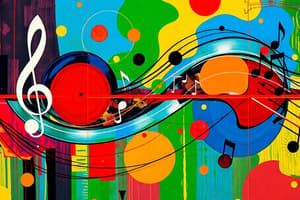Podcast
Questions and Answers
Qual elemento musical se refere ao padrão de sons e silêncios na música?
Qual elemento musical se refere ao padrão de sons e silêncios na música?
- Timbre
- Ritmo (correct)
- Melodia
- Dinâmica
Qual elemento musical é uma série de notas tocadas juntas ao mesmo tempo?
Qual elemento musical é uma série de notas tocadas juntas ao mesmo tempo?
- Dinâmica
- Melodia (correct)
- Timbre
- Ritmo
Qual elemento musical se refere à forma como um instrumento ou voz produz o som?
Qual elemento musical se refere à forma como um instrumento ou voz produz o som?
- Melodia
- Timbre (correct)
- Ritmo
- Dinâmica
Qual elemento musical se refere a mudanças no volume durante uma peça musical?
Qual elemento musical se refere a mudanças no volume durante uma peça musical?
Qual elemento musical não é mencionado no texto?
Qual elemento musical não é mencionado no texto?
O que representa o termo 'pianissimo' na música?
O que representa o termo 'pianissimo' na música?
Qual é a função de um maestro durante uma performance musical?
Qual é a função de um maestro durante uma performance musical?
O que é composição na música?
O que é composição na música?
O que significa 'crescendo' na música?
O que significa 'crescendo' na música?
Qual é a importância do ritmo na música?
Qual é a importância do ritmo na música?
Flashcards are hidden until you start studying
Study Notes
Music is a universal art form that has been around since ancient times. It can evoke emotions and transport us to different places and time periods. There are several basic elements of music that make this possible. These elements include rhythm, melody, timbre, dynamics, conductor, and composition. In this article, we will discuss each of these elements in detail.
Rhythm
Rhythm refers to the pattern of sounds and silences in music. It's what makes you tap your foot or nod your head when listening to your favorite song. A common misconception is that rhythm is only composed of beats, but it also involves tempo—the speed of those beats. For instance, a fast tempo could lead to a lively feeling, while a slow tempo may convey a sense of tranquility.
Melody
Melody is a series of notes played together at one time. It is often considered the most accessible element of music because it's what sticks in our heads after hearing a catchy tune. Melodies can range from simple and repetitive patterns to complex compositions with numerous twists and turns throughout.
Timbre
Timbre, sometimes referred to as tone color or register, is how an instrument or voice produces sound. Every instrument produces its own unique sound based on factors such as size, material, and shape. This diversity in sound allows for more vivid expression within music.
Dynamics
Dynamics refer to changes in volume during a piece of music. They create contrast and tension, which adds depth and interest to the overall composition. Some common dynamic terms include pianissimo (very soft), mezzo piano (medium soft), mezzo forte (medium loud), fortissimo (very loud), and crescendo (gradually getting louder).
Conductor
A conductor is responsible for leading a group of musicians during a performance. They interpret the composer's intentions regarding timing, phrasing, articulation, and other nuances so that all performers are playing in unison. Without conductors, large ensembles would struggle to synchronize their efforts effectively.
Composition
Composition is the act of writing or creating music. It requires both technical skill and creativity. The musical landscape is filled with various forms and styles, reflecting cultural influences and historical contexts. Some notable examples include symphonies, sonatas, operas, and chamber music.
In conclusion, understanding these basic elements of music enables listeners to appreciate the complexity and richness inherent within any musical piece. By recognizing how rhythm, melody, timbre, dynamics, conducting, and composition work together, one gains a deeper connection with the artistry behind the music.
Studying That Suits You
Use AI to generate personalized quizzes and flashcards to suit your learning preferences.




